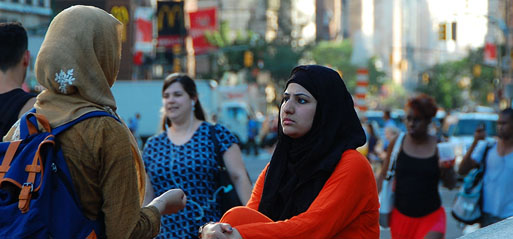
(Photo credit: Pxhere/Commons)
Hamed Chapman
Muslims in the US are more likely to be younger, and more pious but poorer than other religious groups, though as likely as others to be college-educated, according to the latest report from the Institute for Social Policy and Understanding published last month.
The study is the sixth of its kind. It was said to reflect a nation “facing economic struggles, continued racial inequity, gun violence, and an ever-growing partisan divide.” For American Muslims, compared to the general US population, it also shows that COVID has had a disproportionately negative impact, both economically and psychologically.
The American Muslim Poll 2022 presents an updated demographic profile of Muslims as well as other faiths or those of no-faith in the US two years into the COVID-19 pandemic as the world enters a new phase of living with the virus.
An obvious highlight is a significant difference in age distribution, similar to other findings, with 26 per cent of American Muslims surveyed being between the ages of 18–24, while the same age group accounts for only 2–12 per cent of Jewish, Catholic, Protestant, White Evangelical, Non-Affiliated, and the general public.
In contrast, there are only seven per cent of American Muslims aged over 65 and over, compared to over a quarter of Jews and Catholics, and over a third of Protestants and white evangelicals.
The implications are that American Muslims will be more likely to contribute to the labour force, pay taxes, and, with a larger share of the population being of child-bearing age, continue to grow faster.
The survey found American Muslims are the faith community most likely to be poor, with one-third having a household income of less than $30,000 and only one-fifth earning $100,000 or more.
The latter statistic is on par with all other groups except American Jews, with 44% of Jewish Americans earning $100,000 or more and only 12% earning less than $30,000.
When breaking income statistics down by ethnicity, Black Muslims (as well as Black Americans in the wider population) are more likely to report having a lower income, with 41% of Black Muslims reporting an income of less than $30,000 per year.
This is more than 25% of whites, 23% of Asians, and 29% of Arab Muslims.
In terms of religious observance, the 2022 report found that seven-in-ten American Muslims told the researchers that religion is a “very important” part of their lives, second only to white Evangelicals (83%).
Both Muslim men and women were nearly identical in their respective viewpoints that religion is “very important” to their daily life (71% of Muslim men and 69% of Muslim women).
Muslims of all ages were equally likely to rate religion as “very important” to their daily life, suggesting that devotion to faith will endure into the next generation, even for young Muslims.
When it comes to education levels, 46% of American Muslims have a college degree or higher, which is on par with 47% of Catholics but greater than the proportions of Protestants (38%), white Evangelicals (38%), non-affiliated (38%), and the general public (38%).
The only faith group with a higher proportion of college degrees was American Jews, with 60% obtaining a degree.
Race tensions continue to challenge Muslim communities, just as they do the rest of the US. Though Muslims, in general, particularly non-Black Muslims, support popular racial equity movements and ideas such as Black Lives Matter and Critical Race Theory.
For the fourth year, the report included an Islamophobia Index, a measure of the level of public endorsement of five negative stereotypes associated with Muslims in the US. Although over time, Islamophobia was found to have declined among some groups, it had risen among Muslims, particularly white Muslims.
To make sense of the increase, it suggested further research was needed to explain why some Muslims appeared to be endorsing negative stereotypes about their communities, which is often referred to as internalised oppression, or internalised bigotry or racism in the case of a racial group.